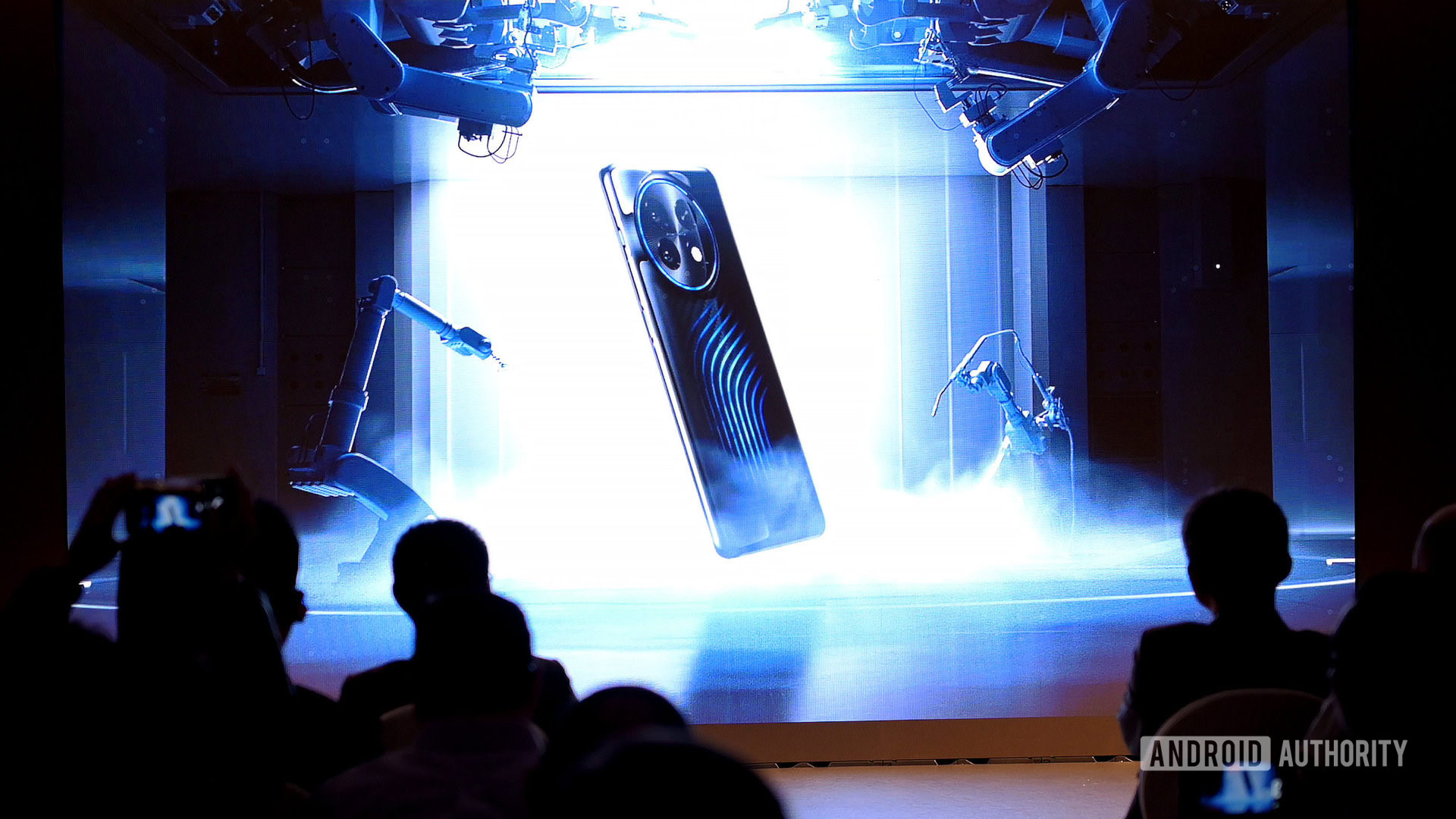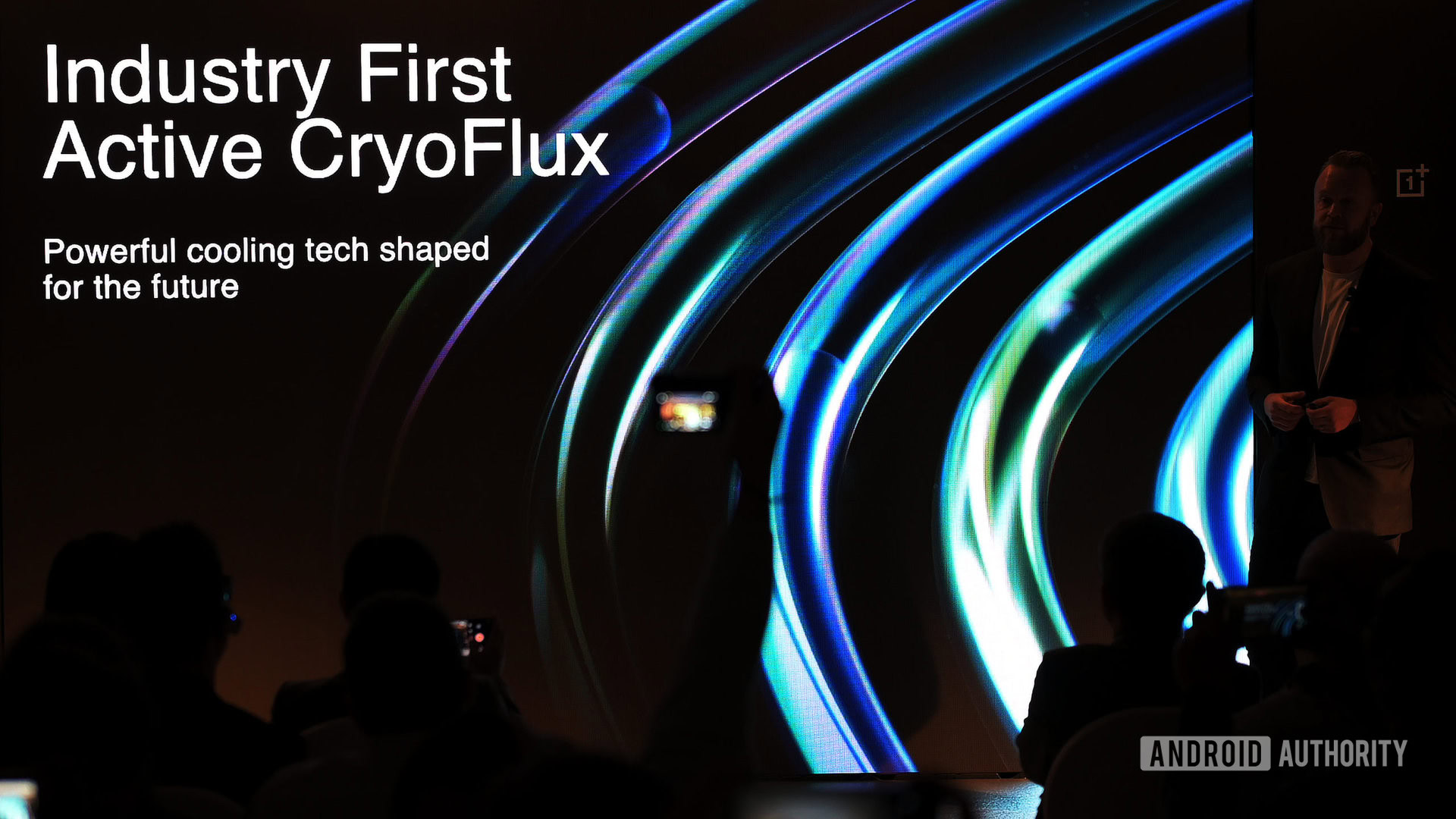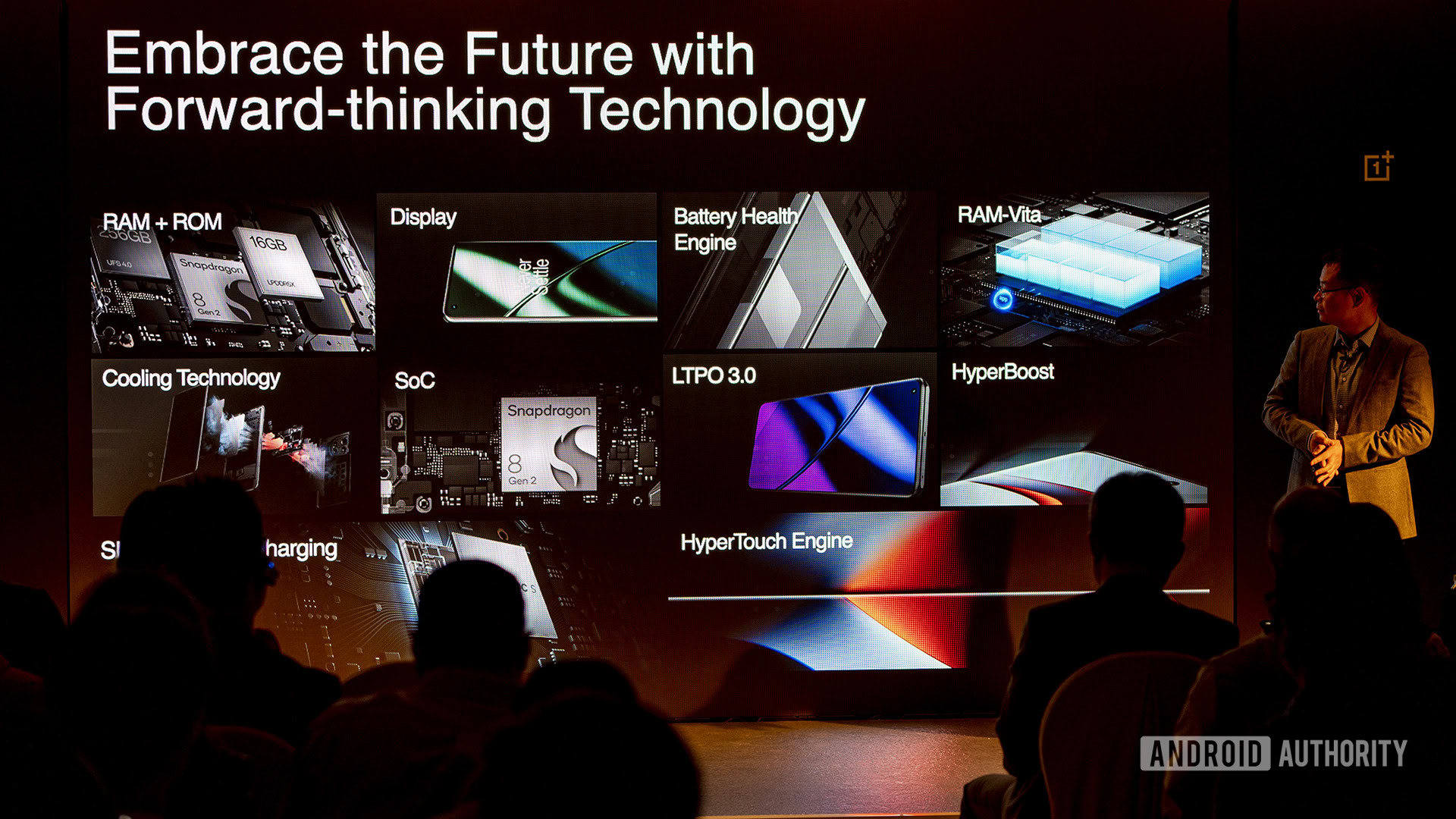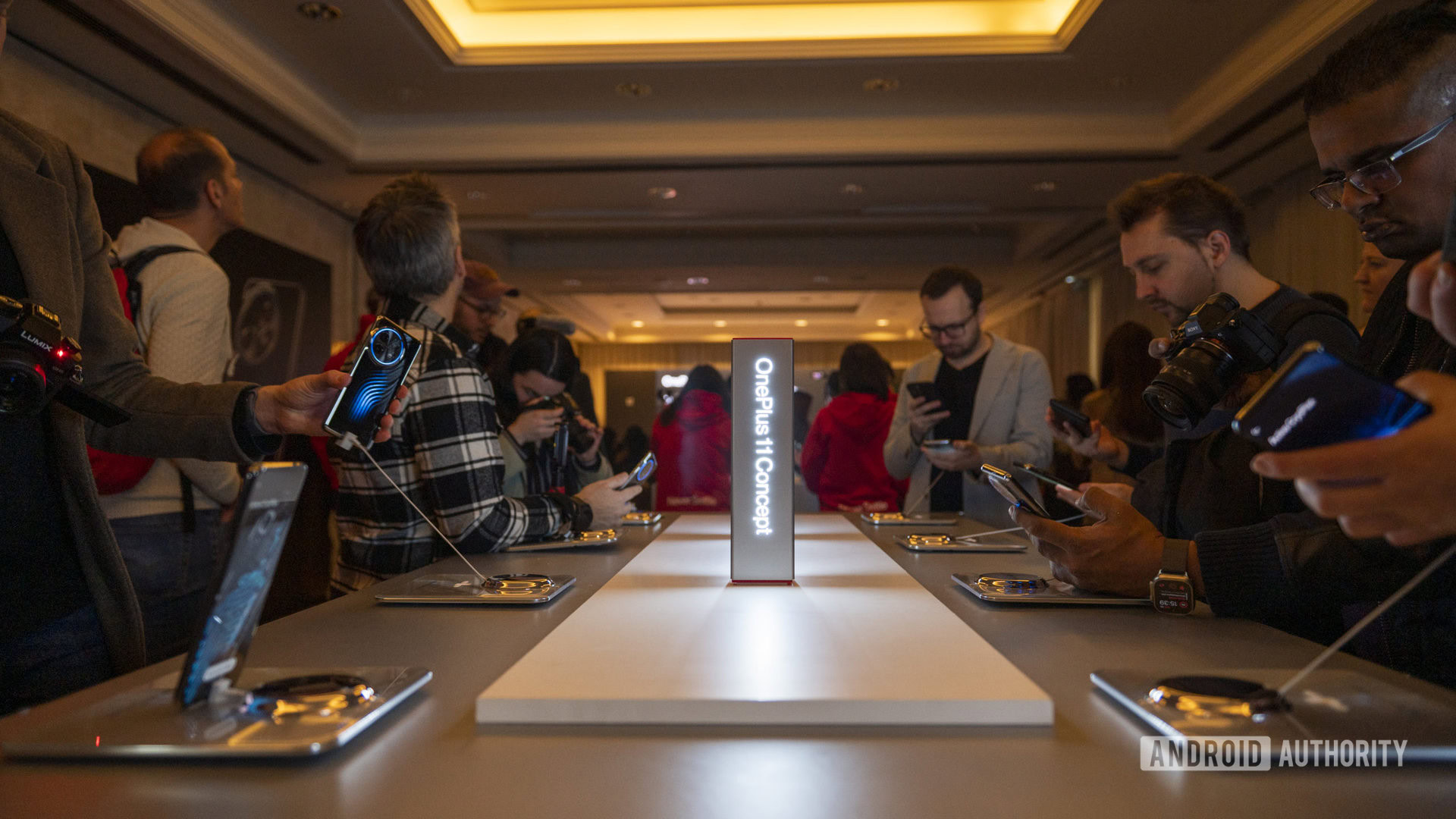Affiliate links on Android Authority may earn us a commission. Learn more.
OnePlus 11 Concept hands-on: Liquid cooling is neat, but does it work?
Published onFebruary 27, 2023
Over the past few years, OnePlus has used tech trade shows to launch what it calls “Concept” phones — devices that show off some brand new feature, but that the company will likely never sell. At CES 2020, the OnePlus Concept One featured electrochromic glass that concealed the rear camera when not in use. Right before CES 2021, we had the OnePlus 8T Concept, which featured a color-changing back. Now, at MWC 2023, we have the OnePlus 11 Concept.
Like previous Concept phones, OnePlus has no plans to release this device commercially. However, it did actually create a working model, and we got some hands-on time with it. Here’s what we saw!
OnePlus 11 Concept: Design

When we first saw the phone, we couldn’t help but chuckle a bit to ourselves because it reminded us immediately of the Nothing Phone 1. On the back of that phone is what’s known as The Glyph — a set of LED lights that can be used for notifications and other functions. Carl Pei started Nothing after he left OnePlus, which he co-founded. It’s delightfully coincidental that OnePlus would create such a similar-seeming device only a year after Pei debuted his own.
However, the back of the OnePlus 11 Concept isn’t just a bunch of LED lights. Instead, a series of channels houses a liquid coolant that OnePlus calls Active CryoFlux. Essentially, this is similar to what liquid-cooled gaming PCs use to keep internals from overheating during intense gaming sessions. OnePlus says this took two years of development and resulted in 30 new patents.
The back of the phone is not just lights: it's a liquid cooling system.
We’ll review Active CryoFlux in more detail in the next section. To add the coolant to the phone, OnePlus made the back glass clear (in the middle, at least) and slotted the 0.2cm² micropumps between it and the phone’s body. In other words, the phone is only nominally thicker and heavier than the normal OnePlus 11.
To add to the premium nature of the phone, OnePlus also added a “magnetron-spluttering coating,” which is when metal is splattered in tiny amounts using an electric field. It sounds really fancy, but it creates such a subtle effect that you probably wouldn’t even notice if someone didn’t point it out to you.
The coolant system isn’t only in the middle of the back of the phone. Active CryoFlux also wraps around the rear camera module. This creates a cool halo effect that makes the phone look pretty classy, although it’s strange to think the module is being cooled for no real reason. We asked OnePlus about the reasoning behind this decision, but it didn’t get back to us before publishing.
Additionally, the lens area of the camera is surrounded by Guilloché etching. This is normally used on expensive watches and is much more apparent than the magnetron-spluttering coating. OnePlus claims this is the first time Guilloché etching has been used on a smartphone.
All in all, the OnePlus 11 Concept looks and feels like a very, very fancy OnePlus 11. But does Active CryoFlux actually bring any benefits to the table, or does it just look neat?
How does the Active CryoFlux cooling system work?

Two piezoelectric ceramic micropumps are sandwiched between the back glass and the phone’s body. These pumps are connected to tiny liquid channels that are filled with a coolant (a combination of oil, water, and mica powder, according to OnePlus). As you use the phone, the liquid pumps all around the back, helping dissipate the heat created by the phone’s internals.
OnePlus claimed that, in laboratory tests, this system can drop the phone’s temperature by up to 2.1 degrees Celsius. During a heavy gaming session, this could increase framerates by a small amount (think 3 or 4 frames). Likewise, during charging, the company claims the coolant drops the phone’s temperature by 1.6 degrees Celsius. While this sounds impressive, it only shaved about 30-45 seconds off the overall charging time.
OnePlus says this system cools the phone, but we weren't able to corroborate that for ourselves.
Unfortunately, OnePlus did not let us remove the Concept from the show floor, so we were unable to do any testing on it for ourselves. As such, all we have are OnePlus’ claims on the matter. During the short time I had with the phone, though, I didn’t feel any difference between the temps at the middle of the back of the phone and the rest of it. Theoretically, I should have been able to feel a 2.1-degree Celsius difference (that’s a difference of 3.9 degrees Fahrenheit). However, the temperature across the entire phone felt the same.
Interestingly, I also couldn’t feel or hear the liquid moving. The room we were in was quite loud, so it’s possible I just couldn’t hear it over the noise. But even holding my finger directly over the coolant produced no vibration or other sensation, despite it moving pretty quickly. Once again, it’s possible I could have felt it if I had more time with the device, but OnePlus only gave journalists a limited amount of time. It’s also possible that these tiny pumps are so small and so efficient that you would never hear or feel them doing their thing.
Basically, OnePlus claims that CryoFlux drops temps, increases frames, and reduces charging time. However, we can’t independently corroborate that and we were left with a lot of questions after using the phone.
What else is different from the regular OnePlus 11?

Inside, the OnePlus 11 Concept is identical to a retail OnePlus 11. That means it has a Snapdragon 8 Gen 2 processor, the same camera system, and the same battery capacity and charging speeds.
In other words, the Concept is only different in its appearance. Obviously, the cooling system adds some new functionality to the device, but this probably wouldn’t dramatically alter how you use it. This system also barely adds any additional weight or thickness to the phone, so not much is different there, either. One would assume the system would add extra battery drain to the device that wouldn’t be present on the regular OnePlus 11. Interestingly, OnePlus told us that the system actually “extended the stability and battery life to avoid overloading or high-power consumption conditions.” Once again, we would have loved to corroborate this claim, as the idea that a pumping system on a smartphone extends battery life is quite bold. But that testing wasn’t possible.
The Guilloché etching and magnetron-spluttering coating certainly are different, too. However, these additions likely would increase the cost of the phone and don’t really add enough to the look of the device to make it worth it. Still, these two accoutrements do make the Concept different from the OnePlus 11.
In the end, the Concept is just a fancy OnePlus 11. However, don’t plan on ever getting one.
OnePlus 11 Concept: You’ll probably never get this

This is the third time we’ve seen OnePlus launch a Concept device. Each time, OnePlus immediately confirms that it has no plans to bring this phone to market. However, not only have we never seen a Concept device come to market, but we’ve never seen any of the aspects of a Concept phone make it to a OnePlus retail model.
The electrochromic glass of the OnePlus Concept One has never made it to a commercial OnePlus phone, and neither has the color-changing back of the OnePlus 8T Concept. As such, we are pretty confident Active CryoFlux, Guilloché etching, and magnetron-spluttering coating are not coming to any OnePlus phones anytime soon.
Would you buy the OnePlus 11 Concept if you could?
Of course, that doesn’t mean you, the consumer, can’t change OnePlus’ mind. If there’s a huge demand for technology like this, OnePlus (and other companies) could surely be persuaded to sell it. Vote in the poll above to sound off on whether or not this is something you’d buy.
Regardless, this phone probably cost a ton of money to create. The three aspects that make this different from the OnePlus 11 seem to be incredibly expensive, which could possibly drive up the retail price to astronomical heights. It seems unlikely that buyers would be willing to spend significantly more money just to gain a few extra frames while gaming or shave a few seconds off the charging time.
Still, it’s always nice to see companies go out on a limb with something different. The OnePlus 11 Concept might not be market-ready, but we’re glad it exists, and we enjoyed checking it out.